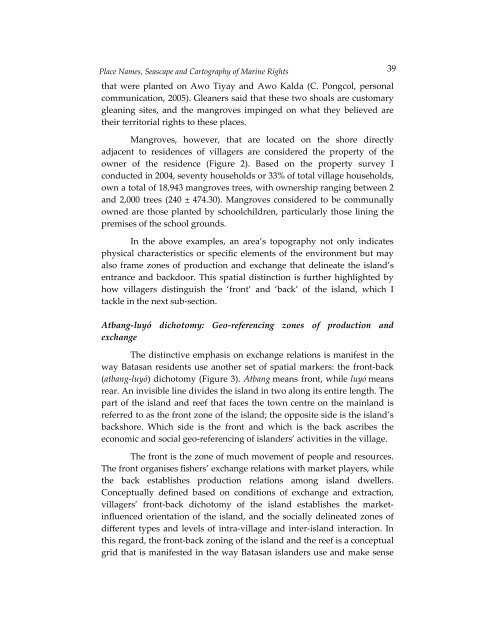Create successful ePaper yourself
Turn your PDF publications into a flip-book with our unique Google optimized e-Paper software.
Place Names, Seascape and Cartography of Marine Rightsthat were planted on Awo Tiyay and Awo Kalda (C. Pongcol, personalcommunication, 2005). Gleaners said that these two shoals are customarygleaning sites, and the mangroves impinged on what they believed aretheir territorial rights to these places.Mangroves, however, that are located on the shore directlyadjacent to residences of villagers are considered the property of theowner of the residence (Figure 2). Based on the property survey Iconducted in 2004, seventy households or 33% of total village households,own a total of 18,943 mangroves trees, with ownership ranging between 2and 2,000 trees (240 ± 474.30). Mangroves considered to be communallyowned are those planted by schoolchildren, particularly those lining thepremises of the school grounds.In the above examples, an area’s topography not only indicatesphysical characteristics or specific elements of the environment but mayalso frame zones of production and exchange that delineate the island’sentrance and backdoor. This spatial distinction is further highlighted byhow villagers distinguish the ‘front’ and ‘back’ of the island, which Itackle in the next sub-section.Atbang-luyó dichotomy: Geo-referencing zones of production andexchangeThe distinctive emphasis on exchange relations is manifest in theway Batasan residents use another set of spatial markers: the front-back(atbang-luyó) dichotomy (Figure 3). Atbang means front, while luyó meansrear. An invisible line divides the island in two along its entire length. Thepart of the island and reef that faces the town centre on the mainland isreferred to as the front zone of the island; the opposite side is the island’sbackshore. Which side is the front and which is the back ascribes theeconomic and social geo-referencing of islanders’ activities in the village.The front is the zone of much movement of people and resources.The front organises fishers’ exchange relations with market players, whilethe back establishes production relations among island dwellers.Conceptually defined based on conditions of exchange and extraction,villagers’ front-back dichotomy of the island establishes the marketinfluencedorientation of the island, and the socially delineated zones ofdifferent types and levels of intra-village and inter-island interaction. Inthis regard, the front-back zoning of the island and the reef is a conceptualgrid that is manifested in the way Batasan islanders use and make sense39



